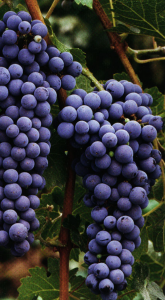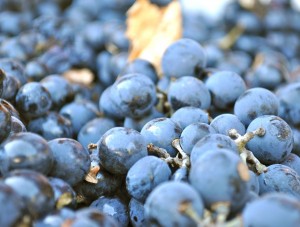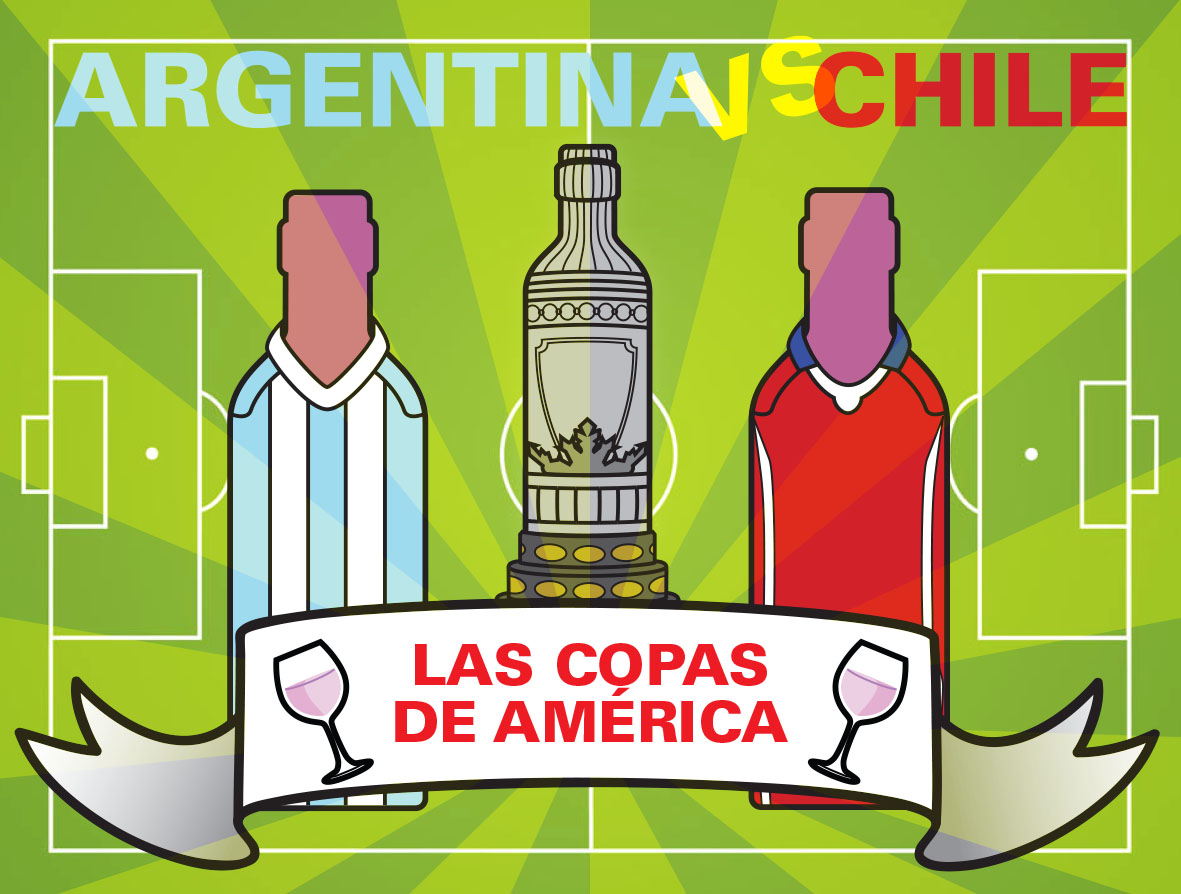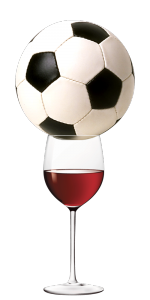It is an exciting prospect for football fans and oenophiles that Chile and Argentina battle it out head to head this weekend in the final of Copa America 2015. For football fans, it is self explanatory. But for wine lovers, it just takes a drop of creativity to see this as a great opportunity to make a battle of the bottles between Chilean and Argentine wine! Do you want to work out whether Malbec from Chile or Argentina is better? Or perhaps Cabernet Sauvignon? Or any other red wines?
Just for kicks, I’m going to put some of Chile and Argentina’s top wines head to head in ‘Copas de America’ wine-off each day till Saturday…
The Copa America of Wine Finals…
Oddball Reds
Both Argentina and Chile’s wine teams are accruing many misfits that are upping the game. Chile is delving into its old roots – Carignan, Pais, Mouvedre, Grenache and aforementioned Malbec (below). The revolution down south is not to be smirked at, and you’ll discover some key varieties that will be – if they aren’t already – main players in the wine scene.
Argentina has another national player in its ranks – Bonarda. Once the workhorse variety of Argentina, Bonarda was replaced largely by Malbec but it has never been out of the game. Its territory is mainly around San Juan where you get great value, full-fruit wines. Another oddball in the family is Tempranillo, finding a natural home is La Consulta and San Carlos in the Uco Valley.
Chilean oddballs Argentine oddballs
The Game: Slow game from the South Diversifying the Malbec game
The Player: Honest (no tricks) grass roots players Round, full fruit, good value players
The Tactic: The long game Filling the gaps in the field
The Verdict?
Chile’s oddballs are more diverse and more populated. There are more players to keep your eye on, and some will make you dribble. Argentina’s oddballs provide good value, but the nation needs to up the diversity in its game.
Chile
De Martino: A forerunner of the Vigno Carignan movement, with plenty of other interesting wines too
Errazuriz: Try the Garnacha red blend for yum power
Bodega RE: Making a whole lot of delicious oddballs
Cacique Maravilla: Small producer of rustic Pais and Pais blends from Itata
Garcia Schwaderer: A gamut of delicious reds from Itata
Argentina
Cara Sur: Super Criolla and Bonarda from Barreal
O Fournier: A top apostle of Tempranillo, try their A Crux!
Karim Mussi: Another Tempranillo-fan making some excellent examples in Alto Cedro
Las Perdices: Good Bonarda and also training up lots of other oddball varieties
Passionate Wines: Fresh Bonarda Beaujolais-stlye! Try their Semillon while you are at it!
Semi Finals…
Cabernet Sauvignon
One of the main varieties across the globe, Cabernet is notoriously easy to grow but difficult to really nail. Chile is leading the pack with the Cabernet Sauvignon having achieved a very well known style of Cab, especially from Maipo (not to be confused with Maipu in Argentina!) and the central valleys. It is one of Chile’s best value varieties, and also one of the most expensive premium varieties.
Argentina on the other side of the Andes seemed to have relegated their Cabernet from the game since Malbec took the headlines. But it has been a consistent player, producing solid wines – albeit less striking or attention calling as Malbec. Try some high quality Cabernet from the warmer regions (Salta & Cafayate, Maipu) and you’ll find spicy, ripe wines that age well and are interesting to drink.
Chilean Cab Argentine Cab
The Game: Bright, berry burst fruit. Cassis kick. Sweatier, earthier fruit
The Player: Great range – from fruit driven, to power structure Ripened player, round
The Tactic: Ticks all the boxes, a show pony Underrated talent
The Verdict?
Chile would still take the trophy on this one. Argentina needs to bring a few more players to the game and get their Cabs in training. One Cabernet player that is taking a lead in Argentina is Cabernet Franc – their latest Cab recruit that is premier league.
Key players? (5-a-side)

Aristos: Elegant and reigning supreme… (If you can’t afford this player try juicy Clos de Fous by same winemaker)
Aquitania: High cassis notes from Alto Maipo, beautiful
Antiyal: Understated Cab beauty with a biodynamic philosophy
Domus Aurea: Excellent single-site Cabernet producer in Clos Quebrada de Macul
Concha y Toro: A Cab for every price point, and an irresistible football endorsement for this article
Argentina
Pulenta Estate: Rich Cabernet and excellent blend to boot
Noemia 2: When the year is right, this Patagonia Cab is a winner
El Porvenir: Intense Cab from sunny Salta
Sophenia: An Uco Valley producer with well performing Cabs
Clos de Chacras: Good value Cabs from this Chacras winery
Quarter Finals…
Malbec

While Malbec has been waiting in the wings in Chile for centuries, it is of course Argentina where it made its name – across the country in northern regions like Cafayate & Salta, and La Rioja, and middle regions like Mendoza, San Juan and San Rafael, and even in Argentine Patagonia – Rio Negro, Chubut and Neuquen.
So… the play off?
Chilean Malbec Argentine Malbec
The game: More shy but, racy acidity Smooth, supple and generous
The player: Darker fruit character Rich, red fruit hero
Tactic: Surprising Malbec High-hitting violets
The verdict?
Both countries (and their different regions) produce very different Malbecs, and very worthy wines. But if you throw all the Malbec players in the game, Argentina still come out tops. Although they shouldn’t play lazy – Chile has some dark horses in the game.
Key Players (9-a-side)
Chile
Viu Manent: One of the classic Malbec producers in Chile, lots of ranges
Rogue Vine: Divine old vine Malbec from Itata
Odfjell: Lovely fruit-driven Malbec from Lontue
Truly Irresistable Malbec Bio Bio, The Co-Op (UK): Excellent value Malbec from Bio Bio
Loma Larga: Casablanca winery specialising in red varieties, and a good Malbec
Maquis: Malbec from Colchagua with a fresher style
J Bouchon: Solid Malbecs from Maule
Vultur: Aromatic and fresh Malbec with jasmine notes
Calcu: An attractive offering from Colchagua
Argentina
Achaval Ferrer: Key players in Malbec, lush and showy
Altos Las Hormigas: ‘The Malbec Specialists’, great single vineyard range
Bodega Bressia: Rich Malbecs, often blended for more complexity
Catena Zapata: Brought Malbec to the World Cup, and with good reason
Colome: High altitude Malbecs
Zuccardi: Their top alluvional is a straight-shooter
Mendel: Classic Malbec producer
Riccitelli: Excellent Malbecs from this young producer
Marcelo Pelleriti: Malbec front-liner from Vista Flores

